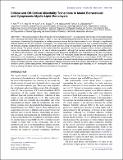| dc.contributor.author | Min, Y. | |
| dc.contributor.author | Alig, T. F. | |
| dc.contributor.author | Lee, Dong Woog | |
| dc.contributor.author | Boggs, J. M. | |
| dc.contributor.author | Israelachvili, Jacob N. | |
| dc.contributor.author | Zasadzinski, J. A. | |
| dc.date.accessioned | 2014-12-12T16:50:16Z | |
| dc.date.available | 2014-12-12T16:50:16Z | |
| dc.date.issued | 2011-03 | |
| dc.date.submitted | 2010-12 | |
| dc.identifier.issn | 00063495 | |
| dc.identifier.uri | http://hdl.handle.net/1721.1/92295 | |
| dc.description.abstract | Monolayers based on the composition of the cytoplasmic (CYT) or extracellular (EXT) sides of the myelin bilayer form coexisting immiscible liquid phases similar to the liquid-ordered/liquid-disordered phases in phospholipid/cholesterol monolayers. Increasing the temperature or surface pressure causes the two liquid phases to mix, although in significantly different fashion for the CYT and EXT monolayers. The cerebroside-rich EXT monolayer is near a critical composition and the domains undergo coalescence and a circle-to-stripe transition along with significant roughening of the domain boundaries before mixing. The phase transition in the cerebroside-free cytoplasmic side occurs abruptly without domain coalescence; hence, the cytoplasmic monolayer is not near a critical composition, although the domains exhibit shape instabilities within 1–2 mN/m of the transition. The change in mixing pressure decreases significantly with temperature for the EXT monolayer, with dΠcrit/dT ∼ 1.5 mN/m/°C, but the mixing pressure of the CYT monolayer varies little with temperature. This is due to the differences in the nonideality of cholesterol interactions with cerebrosides (EXT) relative to phospholipids (CYT). EXT monolayers based on the composition of white matter from marmosets with experimental allergic encephalomyelitis (EAE), an animal model of multiple sclerosis, remain phase-separated at higher surface pressures than control, while EAE CYT monolayers are similar to control. Myelin basic protein, when added to the CYT monolayer, increases lipid miscibility in CYT monolayers; likely done by altering the dipole density difference between the two phases. | en_US |
| dc.description.sponsorship | National Institutes of Health (U.S.) (grant No. GM076709) | en_US |
| dc.description.sponsorship | National Institutes of Health (U.S.) (grant No. HL051177) | en_US |
| dc.description.sponsorship | Canadian Institutes of Health Research (grant No. CIHR MOP 86483) | en_US |
| dc.language.iso | en_US | |
| dc.publisher | Elsevier B.V. | en_US |
| dc.relation.isversionof | http://dx.doi.org/10.1016/j.bpj.2011.02.009 | en_US |
| dc.rights | Article is made available in accordance with the publisher's policy and may be subject to US copyright law. Please refer to the publisher's site for terms of use. | en_US |
| dc.source | Elsevier | en_US |
| dc.title | Critical and Off-Critical Miscibility Transitions in Model Extracellular and Cytoplasmic Myelin Lipid Monolayers | en_US |
| dc.type | Article | en_US |
| dc.identifier.citation | Min, Y., T.F. Alig, D.W. Lee, J.M. Boggs, J.N. Israelachvili, and J.A. Zasadzinski. “Critical and Off-Critical Miscibility Transitions in Model Extracellular and Cytoplasmic Myelin Lipid Monolayers.” Biophysical Journal 100, no. 6 (March 2011): 1490–1498. | en_US |
| dc.contributor.department | Massachusetts Institute of Technology. Department of Chemical Engineering | en_US |
| dc.contributor.mitauthor | Min, Y. | en_US |
| dc.relation.journal | Biophysical Journal | en_US |
| dc.eprint.version | Final published version | en_US |
| dc.type.uri | http://purl.org/eprint/type/JournalArticle | en_US |
| eprint.status | http://purl.org/eprint/status/PeerReviewed | en_US |
| dspace.orderedauthors | Min, Y.; Alig, T.F.; Lee, D.W.; Boggs, J.M.; Israelachvili, J.N.; Zasadzinski, J.A. | en_US |
| mit.license | PUBLISHER_POLICY | en_US |
| mit.metadata.status | Complete | |
